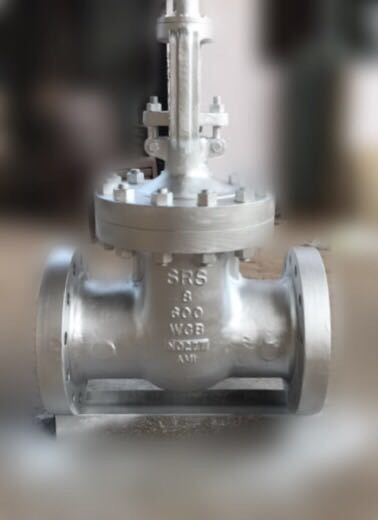Gate valves are primarily designed to serve as isolation valves. In service, these valves generally are either fully open or fully closed. When fully open, the fluid or gas flows through the valve in a straight line with very little resistance. Gate valves should not be used in the regulation or throttling of flow because accurate control is not possible. Furthermore, high-flow velocity in partially opened valves may cause erosion of the discs and seating surfaces. Vibration may also result in chattering of the partially opened valve disc. An exception to the above are specially designed gate valves that are used for low-velocity throttling; for example, guillotine gate valves for pulp stock.
- Need Help? Talk to an Expert +91 93288 79000
- Send Message Us at srsvalves@gmail.com
Gate Valves
Gate Valves
Advantages of Gate Valves
- They Have Good Shutoff Characteristics
- They Are Bidirectional
Disadvantages of Gate Valves
- Gate Valves Are Not Quick Opening Or Closing Valves. Full-stem Travel To Open Or Close A Gate Valve Requires Many Turns Of Its Hand Wheel Or An Actuator.
- Gate Valves Require Large Space Envelope For Installation, Operation, And Maintenance.
- The Slow Movement Of The Disc Near The Full-closed Position Results In High-fluid Velocities, Causing Scoring Of Seating Surfaces, Referred To As Wire Drawing. It Also Causes Galling Of Sliding Parts.
- Some Designs Of Gate Valves Are Susceptible To Thermal Or Pressure Binding, Depending Upon The Application.
- In Systems Experiencing High-temperature Fluctuations, Wedge-gate Valves May Have Excessive Leakage Past The Seats Due To Changes In The Angular Relationship Between The Wedge And The Valve Seats Caused By Piping Loads On The Valve Ends.
- Repair Or Machining Of Valve Seats In Place Is Difficult.
Features
- Long Threaded Stem Nut To Provide Long Life And Permit The Removal Of Hand Wheel Even At Full Open
- Spacer Ring And Single Packing Set For Class300 And Above While Only Single Packing Set For Class150. Double Packing’s Can Be Provided On Customer’s Requirement
- Corrugated Steel Gasket For Class150 Valves, Spiral Wound Gasket For Class300 & Class600 Valves, And Ring Joint Gasket For Class900 & Above Valves Or As A Optional For The Class600 Valves On Customer Request
- Integral Guide Ring Inside Body To Assure Self Centering Of Wedge During Open And Closing
- Flexible Wedge To Compensate For Seat Face Distortion And Body
- Deformation Due To Pipe Stress
- Anti Blow Out Stem Design With Collar
- Stem And Wedge Connection Stringer Than The Threaded Area Of Stem
- Renewable Seal Welded Seats With Satellite 6 Are Standard Design While Screwed In Seats Are Optional


Applications of Gate Valves
Socket or butt-welding end-gate valves in air, fuel gas, feed water, steam, lube oil, and other systems are typical applications. Threaded-end gate valves may be used in air, gaseous, or liquid systems. Concern for leakage from threaded connection can be addressed by seal welding the threaded connection or by using thread sealants, as appropriate. In low-pressure and low-temperature systems such as fire protection systems’ water piping or water distribution pipelines, flanged gate valves are commonly used.
Reference Standard
- API 600 Gate Valve – API 600
- Wall Thickness & General Design ≤ Nps24- API 600 , ISO 10434.
- Wall Thickness & General Design ≥ Nps24- ASME B16.34
- Pressure Temperature Rating – ASME B16.34
- Face To Face Dimensions For Buttwelding And Flange Design- ASME B16.10
- Flange Design- ASME B16.5
- Buttewelding Design- ASME B16.25
- Materials – ASTM
- Valve Inspection And Testing – API 600, API 598, BS 6755 PART 1
Size & Rating
- CLASS 150- 2” TO 64”( DN50 TO DN1600) Equivalent EN / DIN Standards
- CLASS 300- 2” TO 64”( DN50 TO DN1500) Equivalent EN / DIN Standards
- CLASS 600- 2” TO 56”( DN50 TO DN1400) Equivalent EN / DIN Standards
- CLASS 900- 2” TO 36”( DN50 TO DN900) Equivalent EN / DIN Standards
- CLASS 1500- 2” TO 30”( DN50 TO DN750) Equivalent EN / DIN Standards
- CLASS 2500- 2” TO 24”( DN50 TO DN600) Equivalent EN / DIN Standards

